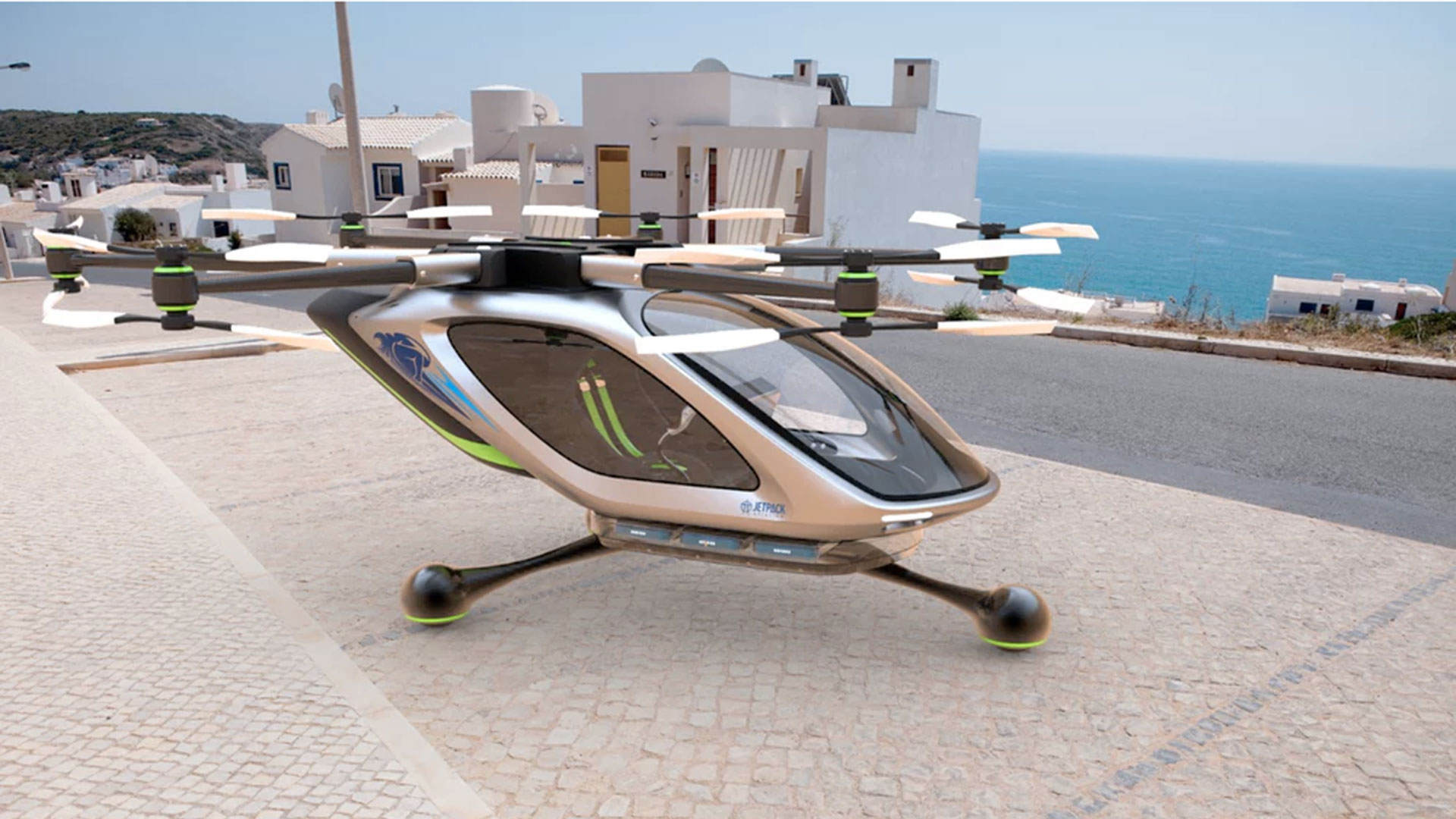

Jetpack Pioneers Working on VTOL Flying Car
With all the attention being paid to autonomous vehicles, it’s easy to forget that another science-fiction fantasy—the flying car—is likewise rushing toward reality.
Back in October of 2015, Uber released a white paper for Uber Elevate, a project exploring the use of self-flying vertical take-off and landing (VTOL) vehicles, to much fanfare; the following month we learned about Project Vahana, an autonomous flying vehicle concept from A³, Airbus Group’s Silicon Valley-based advanced projects division.
Now, David Mayman and Nelson Tyler, the duo behind Jetpack Aviation (JPA), the Van Nuys, California-based company responsible for the world’s first commercially-available personal jet-turbine backpack, have released their own version of the flying car of tomorrow. JPA’s VTOL flying car concept, currently in CAD render stage, is a manned, single-seat multi-rotor vehicle that can fit into a single-car garage thanks to center folding arms (total, the copter has 12 props mounted coaxially on six arms). It joins a field that includes the aforementioned Project Vahana, Larry Page’s Zee.Aero and Kitty Hawk, China’s eHang, and e-Volo, from Germany, among others.

New Atlas has a fascinating interview with Mayman; you can read the whole interview here, or check out notable excerpts, below.
On the Two Schools of Thought About Flying Cars
There’s two schools of thought. You’ve got your winged aircraft with distributed electric propulsion – the Joby, the Airbus, the Zee.Aero – the advantage here is high speed. They can cruise at 2-300 miles an hour (320-480 km/h), so you get speed and range out of that.
David Mayman, via New AtlasWe’re on the other side. We’re taking the manned multirotor approach. More than anything else, because some of the technology’s already proven enough. The speeds are lower – you might be talking about 90 miles an hour (145 km/h), but the size factor is so much smaller because you don’t have a wing to deal with.
Details on JPA’s VTOL Design
The way we’re designing ours, there are actually six arms that come out from the top of the chassis – two at the front, two in the middle and two at the rear. The middle one can fold in. The design direction I’ve given is that it’s gotta fit inside a single car garage. It’ll be low enough and thin enough to do that, because the side arms and motor pods fold in against the chassis.
There’s only one seat in it at the moment, but the beauty of distributed electric propulsion is that it’s very, very scalable. The way that electric motors work, it’s hey, you wanna make something for two people? OK, you just add power to the electric motors. The ultimate limiting factor comes from battery storage density.
David Mayman, via New AtlasWe all – Tesla, everybody working in this space – need it to be higher than the current 200-odd Watt-hours per kilogram we can get at the moment. But they’re talking about in four years, maybe it hits 400. That’s huge, that’s where these electric aircraft will all become very realistic.
On Damage, and Using Wood Versus Carbon Fiber
At this stage we’re going for custom wooden props instead of carbon props. You can get them incredibly light, and they’re much more resistant to damage. With a carbon prop, if you get any damage, like a little stone, or something, they’re pretty much stuffed. A wooden prop is very easy to repair, and there are fantastic little prop makers who can make them any size you want, so they’re not very expensive.
These things operate relatively close to the ground, you’re talking about 2 meters (6.5 ft) off the ground. There’s always the risk of them picking up stuff. I mean, if you look at the eHang 184 out of China, their lower props are literally, they look like 8 inches off the ground. I don’t see how that’s going to work. If you land on ground that’s not perfectly level, or if you come it at a bit of an angle, the prop’s the first thing that’s gonna hit the ground. I’m not quite sure what the thinking was there. But they have raised a lot of money, I’ve heard somewhere around US$80 million.
David Mayman, via New AtlasSo our props come off the top. Obviously that means some added weight, because you have to have that extra strength through the whole airframe structure to carry the load from the top rather than the bottom.
How to Extend Flight Times While Waiting for Advances in Battery Tech
We’re looking at designing something similar to an extended-range electric car, with a generator on board. In fact, we were looking at perhaps building in a turbine motor, thanks to our experience with turbines on the jetpacks. A very small one, a tiny one, the size of a coke can, can produce a lot of power as a generator.
David Mayman, via New AtlasThey do consume fuel faster than, say, a two-stroke motor, but they’re so much lighter that you can carry more fuel. Anyway, it’s one of the concepts we’re looking at. And it could take something from a 20-minute flight time up to an hour with a hybrid range extender.
(Once again, you can read the entire interview at New Atlas here.)